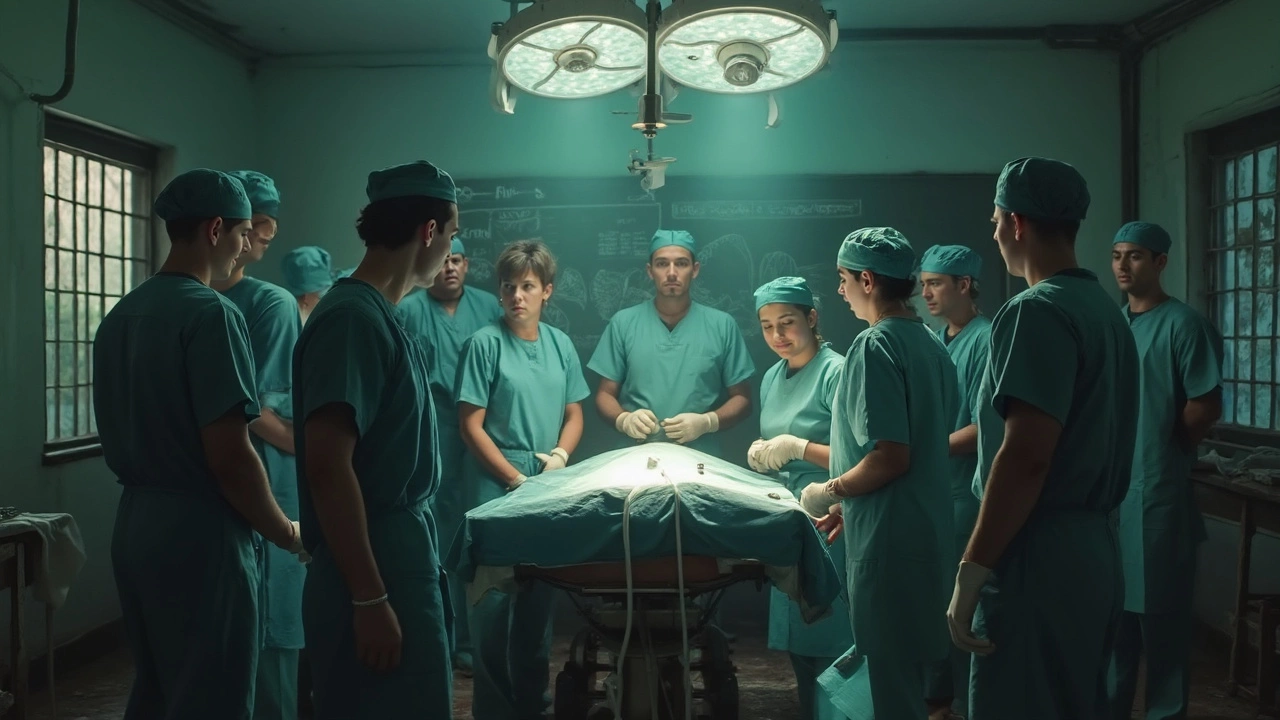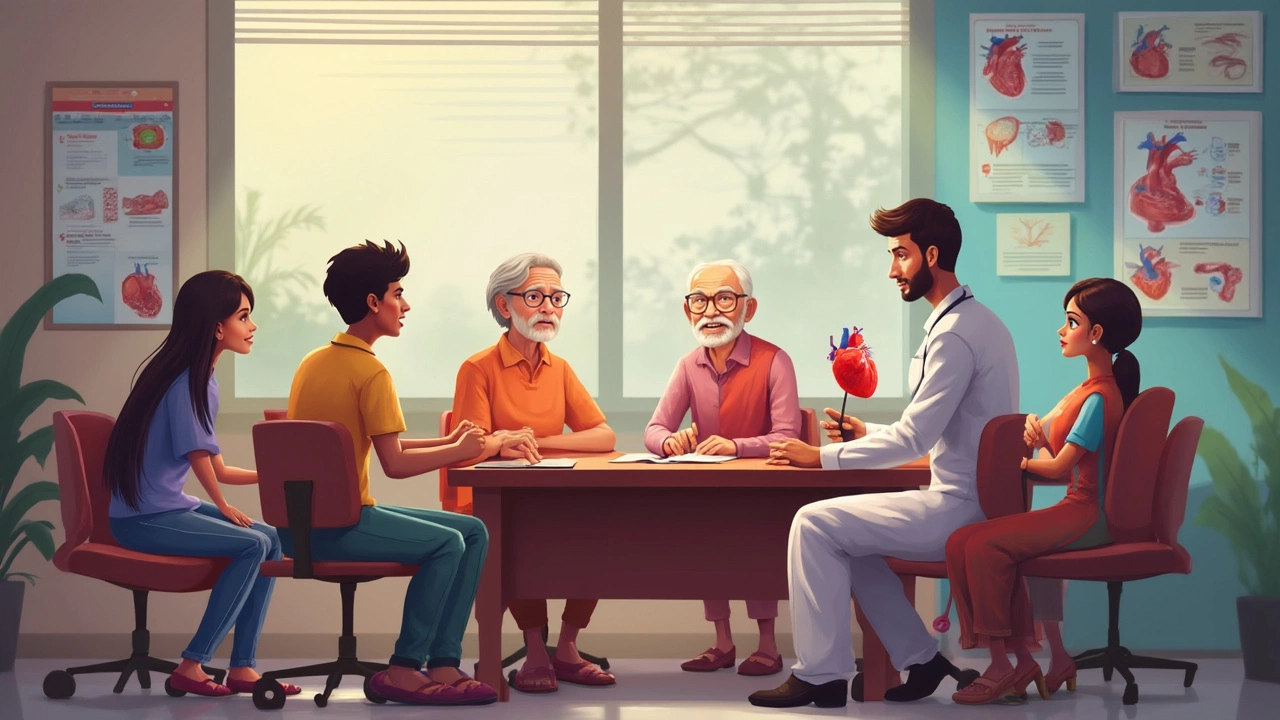-
20

Deadliest Heart Surgery: The Story Behind the Numbers
If you think heart surgery is risky now, just imagine what it was like eighty years ago. Back then, opening up the chest felt closer to a coin toss than a medical plan. We're talking about a time when just surviving the operation was a headline-worthy event.
But which heart surgery actually claimed the title of 'deadliest?' Spoiler: it involved a race against time, no heart-lung machines, and odds even the bravest doctors dreaded. Not all surgeries were the same—different procedures came with different levels of danger, and some quickly earned a reputation for being ruthless.
For anyone facing heart surgery, knowing the history isn't just trivia—it's a lesson in how far we've come, and what questions you should be asking. The right info can help you see past fear and make smarter choices if you're ever in that spot. Stick around, because what comes next might surprise you.
- The Wild History of Heart Surgery
- What Made Certain Surgeries So Dangerous?
- The Infamous Deadliest Operation
- How Modern Tech Changed the Odds
- Tips for Safer Heart Surgery Today
The Wild History of Heart Surgery
The road to modern heart surgery reads like a wild experiment with lives. Back in the early 1900s, cutting into the heart was mostly off-limits—it was called "the seat of the soul" and doctors kept away. The first real breakthrough didn’t happen until 1896, when Dr. Ludwig Rehn successfully closed a stab wound to the heart in Germany. Before that, nobody had survived an operation actually on the heart.
Things didn’t get much safer overnight. By the 1940s, attempts to fix heart valves or defects were still super risky. Surgeons had to work lightning-fast before the patient’s heart or brain ran out of oxygen. The first open-heart surgery with a heart-lung machine didn’t even happen until 1953, when Dr. John Gibbon used his homemade device to save an 18-year-old girl in Philadelphia. Even then, survival rates weren’t great.
"Heart surgery used to be the final frontier. It was much less of a science and much more of a leap of faith," said Dr. Denton Cooley, one of the pioneers of bypass surgery.
Get this: early open-heart surgery survival rates hovered around 10% to 20%. That’s like rolling a die, hoping for your number to come up—a far cry from today’s odds. Here’s how it looked back then:
| Year | Type of Heart Surgery | Average Survival Rate |
|---|---|---|
| 1940 | Manual "closed" heart surgery | ~10% |
| 1953 | First heart-lung machine open surgery | ~20% |
| 1970 | Modern bypass surgery begins | ~90% |
The main reason for those terrible odds? There was no way to keep blood and oxygen flowing to the brain while the heart was stopped. That meant speed was everything. Most patients with complex heart problems didn’t survive long enough to even try surgery.
Looking at these numbers, you can see why people used to think going under the knife for heart surgery was almost a last resort. The tools were basic, knowledge was limited, and even skilled hands couldn’t outsmart biology sometimes. Now, it’s a whole different ballgame, and that change started with those early, gutsy attempts.
What Made Certain Surgeries So Dangerous?
The early days of heart surgery were way riskier than you'd think. Surgeons were literally figuring things out as they went. There were no high-tech monitors, no reliable anesthesia, and, maybe most important, no heart-lung machines. That last one was a huge deal, because until the 1950s, doctors couldn't really keep blood pumping if they had to stop the heart to work on it.
Here’s why some surgeries became death traps:
- No Heart-Lung Machine: Surgery on a beating heart is a nightmare. If the heart stops, there’s only a tiny window—about 4 to 6 minutes—before brain cells start dying from lack of oxygen.
- High-Risk Infections: Sterile technique wasn’t perfect. When infections set in after open-heart surgery, survival rates tanked fast.
- Lack of Imaging: Surgeons were working blind, relying on X-rays and stethoscopes. They didn’t have CT or MRI scans, so sometimes they didn’t know the full problem before cutting.
- Crude Tools and Sutures: Early surgical tools were nowhere near as refined as today’s. Even simple things like sewing up the heart or blood vessels could turn deadly if stitches tore loose.
Just to put it in perspective, check out this snapshot of heart surgery outcomes before major tech improvements:
| Procedure | Year | Reported Survival Rate |
|---|---|---|
| First Heart Valve Surgery | 1923 | 0% (no survivors in the first attempts) |
| Closed Mitral Commissurotomy | 1948 | 50-60% |
| Open Heart Surgery (pre-heart-lung machine) | 1944-1952 | Under 20% |
Many deaths weren’t just from the surgery itself, but also from after-effects like blood clots, kidney failure, or massive bleeding. Recovery rooms weren’t even a real thing until the 1940s. Patients often woke up with a nurse tying off the last stitches and hoping their heart didn’t give out again.
So, bottom line—before tech and techniques improved, every step in the operating room felt like rolling dice with a loaded gun. Knowing this history helps you appreciate the crazy advances that mean better odds today.

The Infamous Deadliest Operation
If you asked surgeons in the late 1940s about the most dangerous operation, the answer was clear: the open heart surgery called "mitral commissurotomy" done before the heart-lung machine showed up in hospitals. Basically, it meant cracking open the chest, stopping the heart, and reaching inside with your bare hands—while the patient hovered between life and death. People called it a miracle if anyone walked out alive.
The reason for the deadly reputation? Operating on a beating heart caused blood loss and a race against brain damage because the body wasn’t getting oxygen. Most surgeries had survival rates below 10%. For every ten patients, only one, if that, made it out. That’s rough by any standard.
The real game-changer was the invention of the heart-lung machine in 1953 by Dr. John Gibbon. Before that, surgeons like Dr. Dwight Harken and Dr. Charles Bailey tried to repair heart valves by slipping tools through small holes in the heart—blindly—hoping for the best. The stats back up how crazy risky these early surgeries were. Take a look:
| Year | Type of Operation | Patients Operated | Patients Survived | Survival Rate (%) |
|---|---|---|---|---|
| 1947 | Mitral Commissurotomy | 8 | 1 | 12.5 |
| 1951 | Blind Valve Surgery | 22 | 4 | 18.2 |
| 1954 | Open Heart with Heart-Lung Machine | 5 | 5 | 100 |
Just seeing those numbers, it’s pretty clear why this kind of deadliest surgery haunted patients and doctors alike. It wasn’t about skill—it was about lacking the right tools. Once technology caught up, those grim stats started disappearing.
If you’re ever reading old medical journals, you’ll see how desperate things got. Surgeons sometimes tried these operations only on patients who were out of options. Back then, just making it off the table meant you were incredibly lucky.
How Modern Tech Changed the Odds
If you went in for heart surgery back in the 1940s or '50s, you were basically relying on your surgeon’s hand skills—plus a dose of luck. Now? The survival odds are way better, and it’s all thanks to a real tech revolution in the medical world.
The first big game changer was the heart-lung machine, which showed up in operating rooms in the 1950s. Before that, surgeons had to work super fast, racing the clock before the heart stopped for good. With the heart-lung machine doing the pumping and oxygen work for your heart, surgeons finally got time to fix the real issue. This single invention caused survival rates to jump for tons of previously deadliest surgeries.
Fast forward to today, and hospitals are packed with gear that surgeons rely on every day:
- Minimally invasive tools: Tiny cameras and robotic arms mean less cutting, smaller scars, and way faster recoveries. Doctors can now fix heart valves or even bypass blocked arteries through teeny incisions between the ribs.
- 3D imaging: Doctors can map out your unique heart structure in ultra-high detail before ever cutting. They see trouble spots and plan exactly how to tackle them, reducing surprises mid-surgery.
- Real-time monitoring: Super accurate monitors tell the team exactly how your body’s handling anesthesia and the operation, which means faster action if something’s off.
- Better medications: Blood thinners, drugs to stop infection, and stuff to keep your heart in rhythm lower the risks before, during, and after the operation.
Want another wild fact? Surgeons now use glue, patches, or special clips instead of old-style stitches in some heart repairs, speeding up healing and cutting the risk of leaks.
All of these upgrades add up. Death rates from open-heart surgery—like fixing valves or blockages—have plunged. Some procedures that used to be a flat-out gamble now have 95–98% survival rates, and patients leave the hospital in just a few days. If you or someone close is facing heart surgery, knowing how tech has boosted the odds offers real peace of mind—and it never hurts to ask your surgeon which tools and methods they use.

Tips for Safer Heart Surgery Today
If the words "deadliest surgery" make you sweat, good news: heart surgery is a lot safer now. But there’s a lot you can do to tip the scales even more in your favor. The trick is to get educated, ask the right questions, and pick the right team.
First off, experience matters. Hospitals that do a lot of heart surgeries tend to get better results. Studies from 2023 say survival rates in high-volume centers can be up to 20% higher than in those that only tackle a few heart cases a year. Choose a hospital and a surgeon who do this stuff regularly.
Before any procedure, have a straight talk with your cardiologist and surgeon. Get clear answers to these questions:
- What exact type of heart surgery am I getting?
- How many times have you (the surgeon) done this operation?
- What’s the usual recovery time?
- What are my individual risks, based on my age and health?
- Are there newer or less invasive options?
- How do you manage pain and complications?
Don't forget about your own homework. Managing existing health issues like diabetes, high blood pressure, or obesity—even for a few weeks before surgery—directly improves your shot at a smooth recovery. Quit smoking if you can, and get moving: patients who walk and do light stretches before surgery bounce back faster.
Here's a quick look at how hospitals stack up when it comes to heart surgery safety (these are average numbers from recent data):
| Hospital Type | Annual Heart Surgeries | Average Survival Rate |
|---|---|---|
| High-Volume (Specialist) | 1000+ | 98% |
| Medium-Volume | 250-999 | 95% |
| Low-Volume | <250 | 90% |
Don’t get too hung up on general averages: your own numbers depend on your health, the type of surgery, and your surgical team's track record. If anything feels off, get a second opinion. Pretty much everyone in the field expects this nowadays, so don’t feel weird about it.
After surgery, follow care instructions religiously. Keep up with rehab, take your meds, and show up to all your check-ups. If something feels wrong, call for help right away—catching problems early is a total game changer.